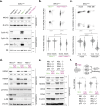Temporal control of human DNA replication licensing by CDK4/6-RB signalling and chemical genetics
- PMID: 40940326
- PMCID: PMC12432183
- DOI: 10.1038/s41467-025-63669-8
Temporal control of human DNA replication licensing by CDK4/6-RB signalling and chemical genetics
Abstract
Cyclin-dependent kinases (CDKs) coordinate DNA replication and cell division, and play key roles in tissue homeostasis, genome stability and cancer development. The first step in replication is origin licensing, when minichromosome maintenance (MCM) helicases are loaded onto DNA by CDC6, CDT1 and the origin recognition complex (ORC). In yeast, origin licensing starts when CDK activity plummets in G1 phase, reinforcing the view that CDKs inhibit licensing. Here we show that, in human cells, CDK4/6 activity promotes origin licensing. By combining rapid protein degradation and time-resolved EdU-sequencing, we find that CDK4/6 activity acts epistatically to CDC6 and CDT1 in G1 phase and counteracts RB pocket proteins to promote origin licensing. Therapeutic CDK4/6 inhibitors block MCM and ORC6 loading, which we exploit to trigger mitosis with unreplicated DNA in p53-deficient cells. The CDK4/6-RB axis thus links replication licensing to proliferation, which has implications for human cell fate control and cancer therapy design.
© 2025. The Author(s).
Conflict of interest statement
Competing interests: T.D.H. is the founder and stockholder of FoRx Therapeutics. The remaining authors declare no competing interests.
Figures





References
-
- Nguyen, V. Q., Co, C. & Li, J. J. Cyclin-dependent kinases prevent DNA re-replication through multiple mechanisms. Nature411, 1068–1073 (2001). - PubMed
-
- Wheeler, L. W., Lents, N. H. & Baldassare, J. J. Cyclin A-CDK activity during G1 phase impairs MCM chromatin loading and inhibits DNA synthesis in mammalian cells. Cell Cycle7, 2179–2188 (2008). - PubMed
MeSH terms
Substances
LinkOut - more resources
Full Text Sources
Research Materials
Miscellaneous

